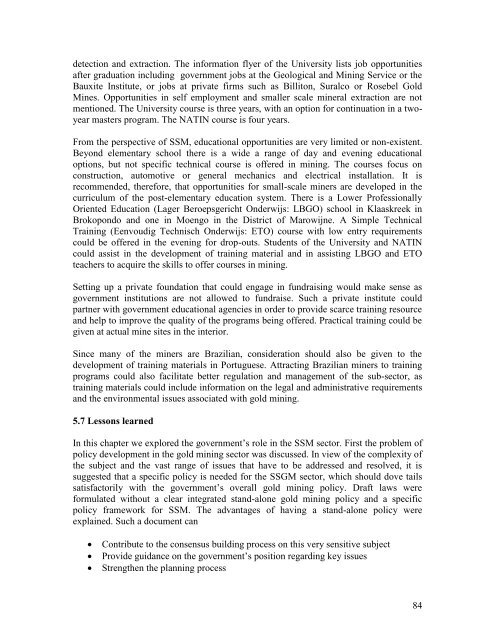SITUATION ANALYSIS OF THE SMALL-SCALE GOLD ... - WWF
SITUATION ANALYSIS OF THE SMALL-SCALE GOLD ... - WWF
SITUATION ANALYSIS OF THE SMALL-SCALE GOLD ... - WWF
You also want an ePaper? Increase the reach of your titles
YUMPU automatically turns print PDFs into web optimized ePapers that Google loves.
detection and extraction. The information flyer of the University lists job opportunities<br />
after graduation including government jobs at the Geological and Mining Service or the<br />
Bauxite Institute, or jobs at private firms such as Billiton, Suralco or Rosebel Gold<br />
Mines. Opportunities in self employment and smaller scale mineral extraction are not<br />
mentioned. The University course is three years, with an option for continuation in a twoyear<br />
masters program. The NATIN course is four years.<br />
From the perspective of SSM, educational opportunities are very limited or non-existent.<br />
Beyond elementary school there is a wide a range of day and evening educational<br />
options, but not specific technical course is offered in mining. The courses focus on<br />
construction, automotive or general mechanics and electrical installation. It is<br />
recommended, therefore, that opportunities for small-scale miners are developed in the<br />
curriculum of the post-elementary education system. There is a Lower Professionally<br />
Oriented Education (Lager Beroepsgericht Onderwijs: LBGO) school in Klaaskreek in<br />
Brokopondo and one in Moengo in the District of Marowijne. A Simple Technical<br />
Training (Eenvoudig Technisch Onderwijs: ETO) course with low entry requirements<br />
could be offered in the evening for drop-outs. Students of the University and NATIN<br />
could assist in the development of training material and in assisting LBGO and ETO<br />
teachers to acquire the skills to offer courses in mining.<br />
Setting up a private foundation that could engage in fundraising would make sense as<br />
government institutions are not allowed to fundraise. Such a private institute could<br />
partner with government educational agencies in order to provide scarce training resource<br />
and help to improve the quality of the programs being offered. Practical training could be<br />
given at actual mine sites in the interior.<br />
Since many of the miners are Brazilian, consideration should also be given to the<br />
development of training materials in Portuguese. Attracting Brazilian miners to training<br />
programs could also facilitate better regulation and management of the sub-sector, as<br />
training materials could include information on the legal and administrative requirements<br />
and the environmental issues associated with gold mining.<br />
5.7 Lessons learned<br />
In this chapter we explored the government‟s role in the SSM sector. First the problem of<br />
policy development in the gold mining sector was discussed. In view of the complexity of<br />
the subject and the vast range of issues that have to be addressed and resolved, it is<br />
suggested that a specific policy is needed for the SSGM sector, which should dove tails<br />
satisfactorily with the government‟s overall gold mining policy. Draft laws were<br />
formulated without a clear integrated stand-alone gold mining policy and a specific<br />
policy framework for SSM. The advantages of having a stand-alone policy were<br />
explained. Such a document can<br />
Contribute to the consensus building process on this very sensitive subject<br />
Provide guidance on the government‟s position regarding key issues<br />
Strengthen the planning process<br />
84
















